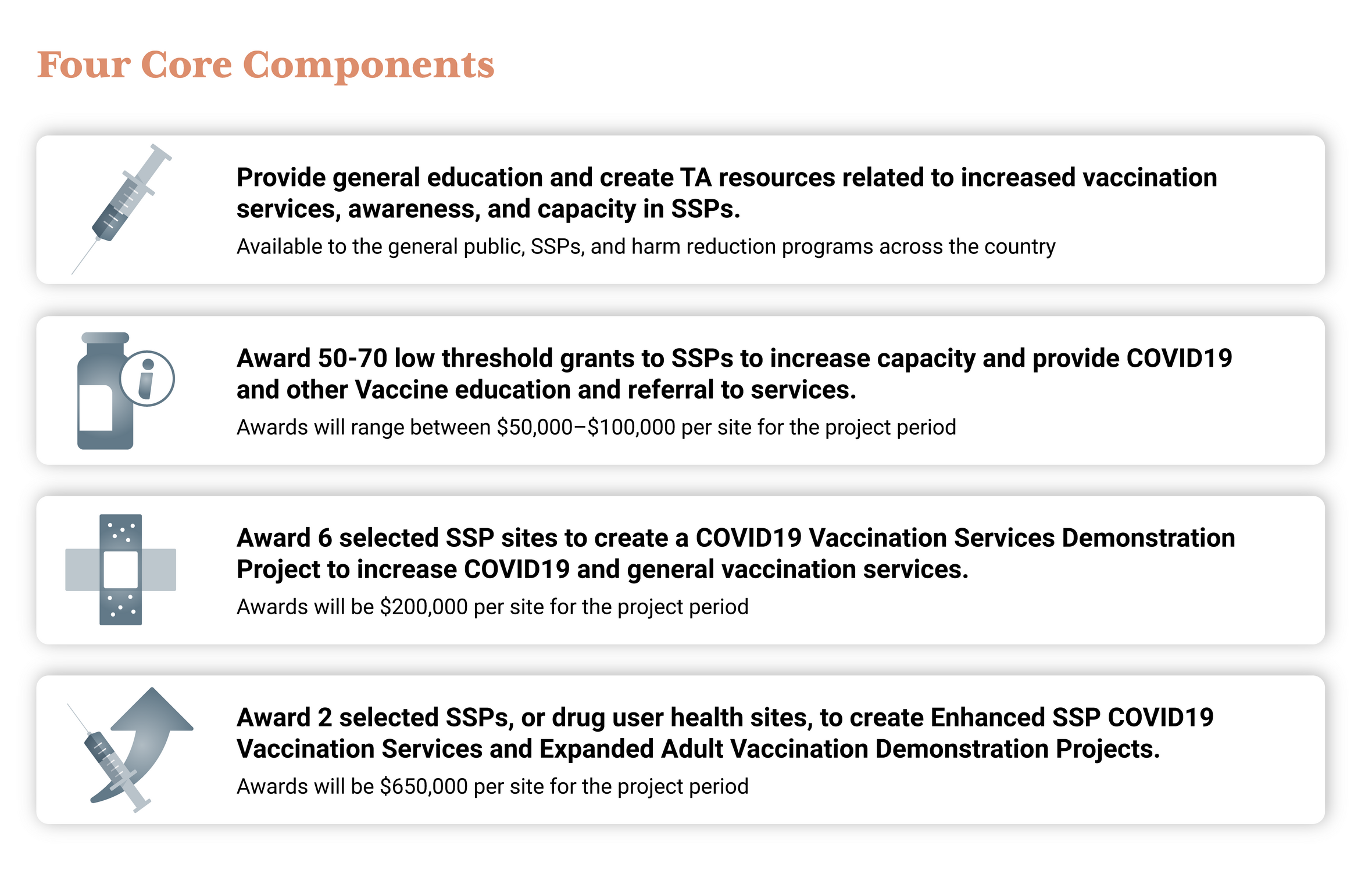Overview of Expanding SSPs to Respond to COVID-19 Project and Funding
In 2022, the Centers for Disease Control and Prevention (CDC) provided funding opportunities to syringe services programs (SSPs) to promote COVID, hepatitis A and B, and influenza vaccine uptake to people who use drugs (PWUD). The funding portfolio for two funders, AIDS United (AU) and NASTAD, included 50 Tier 1 grantees overseen by AU and six Tier 2 and two Tier 3 grantees managed by NASTAD. Tier 1 grantees generally had lower capacity to provide services (e.g., more resource limited financially and/or fewer staff) and received $100,000 in funding to incorporate COVID, hepatitis A or B, and/or influenza vaccination and/or vaccination linkage services, while Tier 2 grantees received $200,000, and Tier 3 grantees (programs with the most robust infrastructure for service delivery and evaluation) received $650,000 each. The initial disbursement of the one-time funding for an eighteen-month period occurred in February of 2022, and a six month no-cost extension was available to all grantees through January 31st, 2024. Facente Consulting was contracted to coordinate and oversee the data collection and evaluation for grantees.
Project Structure
Project Aims
- Engage SSPs in COVID-19 vaccination planning, outreach, and delivery efforts within jurisdictions.
- Enable SSPs to educate their clients/communities about COVID-19 vaccine, promote vaccination, and address hesitancy issues.
- Support SSPs to partner with existing vaccination providers to effectively reach PWUD or to become vaccination providers, receive vaccine supply from jurisdictions, and offer co-located COVID-19 vaccination.
- Build SSP capacity and infrastructure that supports COVID-19 vaccination efforts while delivering effective harm reduction and infectious disease prevention services for people who use drugs.
- Assist in development of long-term capability of SSPs to serve as vaccination providers for COVID-19, hepatitis A/B, seasonal influenza, and other vaccines.
Support core SSP operations related to infectious disease prevention and control through supporting space, staff, and supply needs (as permittable under federal law) without which reaching this population to provide immunization services would not be possible.
Primary Intended Outcomes
- Increased Engagement of Public Health Systems and SSPs
- Capacity-building on COVID-19 and Expanded Adult Vaccination Services in SSPs
- Increased Financial Resources for SSPs to engage in COVID-19 Education, Vaccination and to Address Vaccine Hesitancy among PWUDs and Unstably Housed Individuals
Evaluation of SSP Vaccination Programs and Services and Developing Best Practices and Lessons Learned on creating expanded COVID and other adult vaccination services in SSPs
Flexible RFP, Application, and Selection Process
RFP
To ensure equity among applicants and grantees, AU and NASTAD staff made concerted effort to ensure that the application process was both low-threshold and manageable for prospective grantees. Some of the ways we accomplished this was by:
- The online application was intentionally brief and designed to align closely with concurrently open applications by the Comer Family Foundation and the Syringe Access Fund (now called Harm Reduction Futures Fund) to improve efficiency for programs applying to multiple funders.
- “We really didn’t have much deviation [from the Comer or Syringe Access Fund applications] outside of a few additional...context points that were more COVID specific.”
- Few supplemental components were required beyond the simple grant narrative, budget, and organization demographic tables.
- The application was divided into small subsections, respondents were limited to short answer responses (no more than 300 characters) to further reduce administrative burden.
- Grantees were repeatedly assured that “picture perfect language” wasn’t needed, and rather the core of the proposal was all that would matter to their ability to be funded.
- To ensure that even small organizations that may not have full-time grant writers on staff have an equal opportunity for funding.
- Offered open office hours, in addition to informational webinars to answer any questions or concerns about the application process.
- The opportunity to have “fixed cost” grants (as opposed to requiring applicants to have the infrastructure necessary to meet reporting duties of reimbursement-based grants) also contributed to the diversity of programs that applied for funds. Note: This was specific to Tier 1.
Application Review Process
Applicants for this funding were required to submit diversity tables including the demographic distribution of the Board, staff, and volunteer base of their program. This also included a holistic lens on the applicants and selected programs overall. Some key considerations are included below.
- Reviewers then compared diversity tables to census data for the target region during the review. Extra points were awarded for having proportionate (or better) representation of minority communities, with the diversity of program staff built into proposal scoring rubrics.
- In order to further promote equity amongst selected grantees, additional points were awarded to organizations that had BIPOC, LQBTQ, Sex worker, and leadership with lived/living experience.
- Under resourced organizations were prioritized in the selection process.
- Participating programs ranged in size and operating budget, geographic setting, and rurality/urbanicity, service populations, comprehensiveness of existing services, and organizational structure, representing the breadth of current harm reduction programs and the ongoing uptake of harm reduction approaches by other types of medical and social service providers.
Flexible Data
NASTAD partnered with Facente Consulting to conduct the evaluation of this project Facente Consulting, known for their expertise in program evaluation and data analysis, worked closely with the NASTAD’s grantmaking team and the grantees to assess the effectiveness of the project in achieving its goals. By leveraging Facente Consulting's knowledge and experience, we gained valuable insights and recommendations to enhance the project and further support continued vaccination efforts.
For quantitative data collection, project partners understood the need to balance several priorities:
- Guarantee reporting was manageable for grantees,
- Maintain the ability to demonstrate program effectiveness, and
- Ensure the ability to analyze who is being served, particularly with respect to racial and ethnic disparities.
In order to orient grantees to the reporting process/expectations, Facente Consulting worked with NASTAD to convene a virtual evaluation meeting with all of the eight Tier 2 and 3 programs on April 13, 2022. The meeting goals were to familiarize grantees with Alchemer as a data collection platform, as well as to determine the best path forward for quarterly data collection to ensure a fruitful evaluation model that would also be low barrier for programs to implement.
Facente project staff polled programs using the online interactive platform PollEverywhere to understand programs’ comfort and capacity for each of four options proposed (see table below).
insert table

